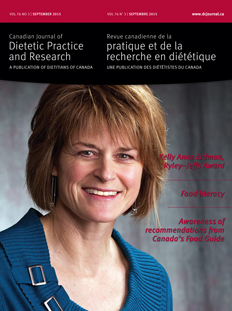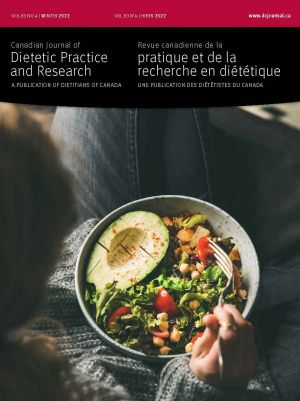Volume 76 • Number 3 • September 2015
Chair's Message
Editor's Message
Original Research
Purpose: To assess dietitians’ perspectives on the importance and applicability of interventions to enhance adherence to dietary advice for preventing and managing chronic diseases in adults in the Canadian context. Methods: Based on a Cochrane systematic review, we identified 8 promising interventions for enhancing adherence to dietary advice: behavioural contracts, exchange lists, feedback based on self-monitoring, individualized menu suggestions, multiple interventions, portion size awareness, telephone follow-up, and videos. Thirty-two dietitians then completed a 3-round Delphi study by responding to an electronic questionnaire asking them to rate the importance and applicability in their practice of the 8 interventions on a 7-point Likert scale. Results: Using a ≥75% level of agreement, 4 interventions showed strong consensus: multiple interventions, feedback based on self-monitoring, portion size awareness, and videos. Among these, the most significant were (means ± SD for importance and applicability, respectively) feedback based on self-monitoring (6.97 ± 0.18 and 6.72 ± 0.46), portion size awareness (6.69 ± 0.54 and 6.75 ± 0.51), and multiple interventions (6.94 ± 0.25 and 6.81 ± 0.40). Conclusions: These findings can guide the development of educational training sessions for dietitians to help them provide practice-relevant interventions that will increase the likelihood that patients adhere to their advice regarding prevention and management of chronic diseases.
Purpose: To assess the bioavailability and safety of vitamin D3 from fortified mozzarella cheese baked on pizza. Methods: In a randomized, double-blind trial, 96 apparently healthy, ethnically diverse adults were randomized to consume 200 IU or 28 000 IU vitamin D3 fortified mozzarella cheese with pizza once weekly for a total of 8 weeks. Blood and urine samples were collected at baseline (week 1) and final (week 10) visits for serum 25-hydroxyvitamin D and other biochemical measures. The primary outcome compared serum 25-hydroxyvitamin D between groups at 10 weeks. The secondary outcome evaluated the safety of vitamin D dosing protocol as measured by serum and urine calcium, phosphate, creatinine, and serum parathyroid hormone (PTH). Results: Serum 25-hydroxyvitamin D increased by 5.1 ± 11 nmol/L in the low-dose group (n = 47; P = 0.003), and by 73 ± 22 nmol/L in the high-dose group (n = 49; P < 0.0001). None of the subjects in either group developed any adverse events during the supplementation protocol. Serum PTH significantly decreased in the high-dose group only (P < 0.05). Conclusions: Vitamin D3 is safe and bioavailable from fortified mozzarella cheese baked on pizza.
Purpose: We examined the impact of socioeconomic and cultural factors on dietary quality in adult Inuit living in the Canadian Arctic. Methods: Interviews and a 24-h dietary recall were administered to 805 men and 1292 women from Inuit regions in the Canadian Arctic. We examined the effect of age, sex, education, income, employment, and cultural variables on respondents' energy, macronutrient intake, sodium/potassium ratio, and healthy eating index. Logistic regression was used to assess the impact of socioeconomic status (SES) on diet quality indicators. Results: Age was positively associated with traditional food (TF) consumption and greater energy from protein but negatively associated with total energy and fibre intake. Associations between SES and diet quality differed considerably between men and women and there was considerable regional variability in diet quality measures. Age and cultural variables were significant predictors of diet quality in logistic regression. Increased age and use of the Inuit language in the home were the most significant predictors of TF consumption. Conclusions: Our findings are consistent with studies reporting a nutrition transition in circumpolar Inuit. We found considerable variability in diet quality and complex interaction between SES and cultural variables producing mixed effects that differ by age and gender.
Purpose: Few efficacious child obesity interventions have been converted into ongoing community programs in the after-school setting. The aim of this study was to evaluate the impact of phase 2 of the Back to Basics cooking club on dietary behaviours and fruit and vegetable variety in a population at risk of obesity at a low income school with > 10% indigenous population. Methods: Baseline and 3-month dietary intake and social cognitive theory (SCT) constructs were collected in 51 children, mean age 9 years, 61% female. McNemar tests were used for comparison of proportions between categorical variables. Cohen's d was used to compare effect sizes across different measures. Results: Consumption of one or more fruit servings per day significantly increased from 41% to 67% (P = 0.02, d = 0.13) and there was a trend for increasing the weekly variety of fruit and vegetables. The SCT constructs assessed within the current study improved significantly (P < 0.05), with moderate to large effect sizes (d = 0.33–0.78). Conclusion: This study documents that a previous efficacious healthy lifestyle program can be adapted for use as an obesity prevention program addressing improvements in vegetable and fruit intakes in a low income community with a relatively high indigenous population.
Purpose: School-based interventions may increase children's preferences for vegetables and fruit (V&F). This Canadian study measured changes in Indigenous First Nations schoolchildren's V&F knowledge, preferences, and home consumption following the implementation of a gardening and V&F snack program. Methods: At baseline, 7 months, and 18 months, children in grades 1–6 (i) listed at least 5 V&F they knew, (ii) tasted and indicated their preferences towards 9 vegetables and 8 fruit using a 6-point Likert scale, and (iii) indicated their home consumption of 17 V&F. Results: At all 3 time points, 56.8% (n = 66/116) of children provided data. Children listed a greater number of V&F at 18 months (4.9 ± 0.1) than at baseline (4.5 ± 1.0) or 7 months (4.7 ± .07) (F(1.6,105.6) = 6.225, P < 0.05). Vegetable preferences became more positive between baseline (37.9 ± 9.3) and 7 months (39.9 ± 9.2), but returned to baseline levels at 18 months (37.3 ± 8.7) (F(1.6,105.8) = 4.581, P < 0.05). Fruit preferences at 18 months (42.7 ± 3.0) were greater than at baseline (41.1 ± 4.3) and at 7 months (41.9 ± 5.1) (F(1.7,113.3) = 3.409, P < 0.05). No change in V&F consumption occurred at home. Conclusions: Despite improvements in V&F knowledge and preferences, home consumption of V&F did not occur. Complementing school-based programs with home-based components may be needed to influence V&F intake of children.
Perspectives in Practice
The term food literacy is emergent, and as a result the literature reflects a great variety of definitions. Simultaneously, new research and food literacy programming is being developed without an agreed upon definition of what food literacy is and how food skills, food security, and health literacy may fit with the definition. We undertook a scoping review and conceptual analysis to identify how the term is understood and to determine shared components of definitions. We found that although most definitions included a nutrition and food skills component, there was great variation in how the ability to access, process, and enjoy food was affected by our complex food system. We propose a definition of food literacy that includes the positive relationship built through social, cultural, and environmental experiences with food enabling people to make decisions that support health. We offer a framework that situates food literacy at the intersection between community food security and food skills, and we assert that behaviours and skills cannot be separated from their environmental or social context. The proposed definition and framework are intended to be guiding templates for academics and practitioners to position their work in education and advocacy, bringing together separate spheres for collective action.
Report
Purpose: To examine use and content knowledge of Canada's Food Guide recommendations. Methods: A total of 1048 intercept exit surveys were conducted with adults who had purchased food that day at 2 hospital cafeterias in Ottawa, Ontario. Results: Most respondents (85.9%) reported looking at Canada's Food Guide over their lifetime; however, less than half reported looking at the food guide in the past year. Milk and Alternatives were the most commonly recalled food group (80.1%) and Grain Products were least commonly recalled (66.0%). Of the entire sample, 42.8% correctly recalled all 4 food groups. Overall, 0.8% correctly recalled the correct number of servings for all 4 food groups. Females, younger respondents, white respondents, respondents with higher annual income, and respondents who had reported looking at Canada's Food Guide recalled more food groups (P < 0.05 for all). Conclusions: Despite high levels of awareness, the study found relatively low levels of reported use and very low levels of knowledge of Canada's Food Guide, particularly among population subgroups that face health disparities. Improving awareness, knowledge, and use of Canada's Food Guide may contribute to improving the nutrition profile of Canadians.
Recognition
OPEN ACCESS
Sports nutrition in Canada has significantly evolved over the years from providing fundamental training dietary advice to applied precise assessment of nutritional status in a variety of settings, especially with the establishment of Canadian Sport Institutes and Centres across Canada. This progression has enhanced the level of dietary support to manage athletes’ nutrition in a holistic perspective. Athletes are now educated about food fundamentals (acquiring foods, menu planning, preparing, food safety), personal accountability of hydration and energy monitoring (urinary and body weight assessments), individualized supplementation protocols, and customized nutrition for variable daily training environments according to their Yearly Training Plan. Sport dietitians are an important member of Integrated Sport Teams where collaboration exists amongst professionals who coordinate the athletes’ personalized training and performance programming. Dietitians in sport are encouraged to continue to lobby for nutrition programming at the elite, varsity, provincial, and club levels to ensure that athletes receive accurate guidance from nutrition experts.
Abstracts
OPEN ACCESS
Bonjour! Welcome to Québec City, the capital of the province of Québec. This historic city was the host of the 2015 Dietitians of Canada Annual Conference. The submissions for this year's Canadian Foundation for Dietetic Research event represented the diversity of dietetic research conducted within Canada. Through the support of Dietitians of Canada and the Canadian Foundation for Dietetic Research, the 2015 event was both an exciting and informative exchange of research and experience-sharing efforts that inspired attendees. The topics highlighted from this year's abstracts include Community-Based Nutritional Care, Wellness and Public Health–Children, Determinants of Food Choice, Dietary Intake, Nutrition Health and Education, Dietetic Practice and Education, Clinical Research and Patient Service, Nutrition Social Media and the Web, Nutrition Labelling and Patient Services. Each presenter provided an 11 minute oral presentation (8 minutes for presenting and 3 minutes for questions). This allowed for meaningful interaction between the presenters and those attending the sessions. This year we had over 50 presentations. These presentations offer the newest insights into important research findings that you may be able to apply to your own practice. This Research Event would not be possible without the commitment and dedication of many people. On behalf of Dietitians of Canada and the Canadian Foundation for Dietetic Research, I would like to extend a special thank you to the 2015 Abstracts Review Committee who represented research, clinical nutrition, community nutrition, and education: Jennifer Brown (Registered Dietitian, The Ottawa Hospital Weight Management Clinic and Bariatric Surgery Program), Marketa Graham (Public Health Dietitian, Ottawa Public Health Unit), Mahsa Jessri (PhD Candidate, Faculty of Medicine, University of Toronto), Hélène Lowell (Nutrition Advisor, Health Canada), and Joseph Murphy (Professional Practice Co-ordinator, The Ottawa Hospital). I would also like to thank all of our moderators who took the time during the conference to keep our research presentation sessions on time. A special thank you to Shilpa Mukund and Greg Sarney at the Canadian Foundation for Dietetic Research for their assistance, patience, and support throughout the review process. I enjoyed interacting with many of you at the oral research presentations where we highlighted the findings from our dietetic colleagues across our country. Marcia Cooper, PhD, RDChair, 2015 Abstracts Review CommitteeHealth Canada










